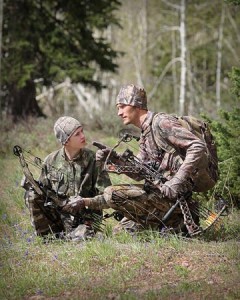How to Start Hunting: A Beginner’s Guide to Western Big Game Hunting
My beginning archery students often ask me how they can start hunting big game. Some have the misconception that all you need to do is learn how to shoot, and then the killing begins! When I explain that there’s a legal process required to start hunting, they are sometimes discouraged. But don’t despair; it’s actually quite easy to start hunting!
In all western states you are required to take a relatively short hunter’s safety course (usually a 10 hour course spanning two weeks), and then a written test. The overall hunter’s education course is really a common sense course on how not to shoot yourself or your companion afield. I can’t stress how easy this course is! But you’ll still learn lots of important tidbits regarding game management, weapon types, shot placement, hunting ethics, etc.
Some states, like Washington, even offer an online course. Other states, such as Utah, require an additional shooting test involving a low-caliber .22 rifle at close range. The shooting test is also quite easy. If you don’t have a .22 rifle, don’t fret; they’re cheap, or you can always borrow one from a friend or classmate.
After completing the hunter’s education course, you’ll receive a numbered certification (called a blue card in Utah) which allows you to hunt for the rest of your life your state, and most others as well.
Below is a list of all the western state’s wildlife resources websites and hunter education course. This is the important first step to start hunting big game:
Arizona: https://www.azgfd.com/education/hunter-education-2/hunter-education-classes
California: https://wildlife.ca.gov/Hunter-Education
Colorado: https://cpw.state.co.us/hunting/education-outreach
Idaho: https://idfg.idaho.gov/hunt/education
Montana: http://fwp.mt.gov/education/hunter/default.html
Nevada: https://www.ndow.org/learn-discover/outdoor-education/
New Mexico: https://wildlife.dgf.nm.gov/education/hunter-education/
Oregon: http://www.dfw.state.or.us/education/hunter/
Utah: https://wildlife.utah.gov/hunting/hunter-education.html
Washington: https://wdfw.wa.gov/hunting/requirements/education/basic
Wyoming: https://fwp.mt.gov/hunt/education/hunter
Once you’ve secured a hunter’s safety certification, it’s time to hunt! Again, every state has its own rules and regulations regarding wildlife management and hunting, including the permit application and licensing process.
Some states, like Utah, Idaho, and Arizona, require that you purchase a license before you can apply for a big game hunting tag. Other states, like Colorado, don’t have license, just a permit which is really a combined license and tag.
The application process generally begins in early spring, or even as early as January. You’ll find these application dates on your state’s wildlife website. The application process can be a little complicated your first time around, but you’ll get the hang of it. Most state’s websites are very helpful and will basically guide you through the process.
As for actually drawing a permit, here’s sort of how it works: In states with lots of game and few humans (i.e. Montana, Nevada, and Wyoming), a general season deer, antelope, or elk might be available for purchase “over-the-counter.” But for the most part, big game tags are in high demand and require that you “apply” for a tag online.
In some states it could take up to 20 years to draw a great once-in-a-lifetime tag (like moose or sheep), but only a couple years to draw a good deer or elk tag. It all depends on the species, the quality of the hunt, and the weapon desired. Archery tags, for example, are easier to draw because they have lower harvest rates, and therefore more tags available.
Most states have a “points” system. This means that for each year you apply for a permit and don’t draw, you’ll receive a point. Once you’ve accumulated enough points, you’ll be guaranteed to draw the tag. A few states, like Idaho, don’t have a point system, so basically you have the same odds as everyone else each year.
Your next question will probably be, “Where should I hunt?” This is a complicated question to answer. There are many things to consider before applying for a hunt, such as:
What species do I want to hunt?
How many days do I have to hunt?
How far am I willing to travel?
What is my hunting budget?
How many years will it take to draw the hunt I desire?
What kind of quality am I looking for? Would I be happy with a small buck or do I want a trophy?
The good news is that information regarding population dynamics and hunter success rates can be found on your state’s wildlife website. Most states put a lot of time and money into gathering information about their various game species, as well as hunter success and permit draw odds. In Utah, for instance, they publish an annual harvest report of every big game species in the state as well as draw odds and success statistics. This information can be invaluable for determining the best places to hunt. With a little study, you can easily figure out where the best hunting is and then apply for that tag.
One last thing: Just because you have a tag doesn’t guarantee you’ll kill anything—it only guarantees you’ll be hunting this fall. In the meantime, it’s time to get outside and scout your unit, especially if you haven’t hunted there before. Scouting is a topic for another day, but for now just remember one thing: don’t wait until the hunt begins to start locating game. Find the animals during the off-season first, then formulate a strategy for opening day.
That’s it folks. If you have any questions about this process, just ask me and I’ll point you in the right direction. Also, feel free to call your local game warden or wildlife agency. Our licensing fees pay their wages and they are almost always willing to help you with any hunting questions. Sometimes they’ll even point you to the best areas to hunt!

